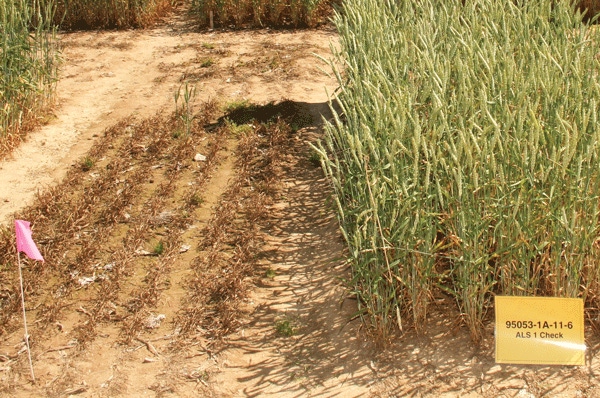
• Clearfield wheat isn’t exactly new. BASF began working with the system back in the 1980s and the first Clearfield varieties were released nearly a decade ago. Clearfield wheat is tolerant to the herbicide Beyond. The first Clearfield wheat variety was called Above. Above and Beyond was a good marketing ploy, but has been slow to be accepted by Virginia farmers.
November 22, 2010

When Virginia Tech Small Grains Specialist Wade Thomason asked a group of wheat growers at a recent field day if they knew about Clearfield wheat, he got mostly blank stares and no response.
After explaining how the new wheat weed management system works, the Virginia Tech researcher got plenty of questions.
Clearfield wheat isn’t exactly new. BASF began working with the system back in the 1980s and the first Clearfield varieties were released nearly a decade ago. Clearfield wheat is tolerant to the herbicide Beyond. The first Clearfield wheat variety was called Above. Above and Beyond was a good marketing ploy, but has been slow to be accepted by Virginia farmers, Thomason points out.
In more recent years Virginia Tech Plant Breeder Carl Griffey has included, first one gene and now two genes with tolerance to Beyond herbicide, into varieties more commonly grown in Virginia.
Jamestown, a popular wheat variety in Virginia, containing both one and two herbicide tolerant genes, was tested at Virginia Tech’s Eastern Virginia Agricultural Research and Extension Center in Warsaw, Va. “With the two genes, we think we have the herbicide resistance we need, now we have to find the right fit with different varieties for growers in the upper Southeast,” Thomason says.
Beyond, and similar herbicides, inhibit the activity of the enzyme, acetolactate synthase (ALS), also known as acetohydroxyacid synthase (AHAS), which is necessary for the biosynthesis of the branched chain amino acids valine, leucine, and isoleucine.
In response to a Beyond herbicide application, ALS is inhibited in susceptible plants depriving them of the previously mentioned, essential amino acids. This causes the eventual death of treated plants.
Clearfield wheat (and other plant crops) is not a genetically modified organism (GMO). It is a mutation, which produces an altered form of the ALS enzyme that is not affected by the herbicide at normal application rates. Beyond herbicide received EPA Federal registration for use in Cleafield wheat in December 2001.
Versatile material
Beyond is labeled to control a wide range of weed pests common to wheat production in the upper Southeast. Italian ryegrass and wild oats are among the grasses it controls. It can control chickweed, henbit and other mustard species and suppresses and may control a number of other broadleaf weeds, including lambsquarters and pigweed.
The weed species controlled or suppressed by Beyond provides some interesting fits for Virginia growers, Thomason says.
If a grower has a field with a history of Italian ryegrass problems, Clearfield may be a good fit. Or, if a grower has chickweed that is resistant to Harmony, that would be another good fit, Thomason says.
Another scenario that may fit is for farmers who would like to grow a rye cover crop, but don’t do it because they are growing small grains. This material can take the ryegrass out and make a rye cover crop more feasible.
This herbicide doesn’t have full residual activity. That may create some problems with lambsquarters. That’s something we will have to keep an eye on when we get farther along with the Clearfield program, Thomason stresses.
“We thought we had something that would work 4-5 years ago with the product. At that time there was only one known gene with the tolerance needed for wheat. About the time Carl Griffey had a variety he thought would work, they found a second tolerant gene, so he started over again,” Thomason says.
“With the single gene we were still getting some herbicide damage to wheat. With the second gene, herbicide damage has virtually gone away. For example, damage rating using the same wheat variety and a double rate of Beyond herbicide were 5 for one gene and less than 1 for two genes.”
Thomason showed the farmers in attendance a plot of Jamestown wheat that did not contain the herbicide mutation gene and was sprayed with Beyond. There was one plant left alive in the plot. The first gene eliminated about 95 percent of the damage and two genes virtually eliminated plant damage in the Virginia tests.
How rapidly the Clearfield technology is accepted and put into use by Virginia farmers will likely depend on how well it works in higher yielding wheat varieties and how it fits into individual farming operations.
About the Author(s)
You May Also Like





